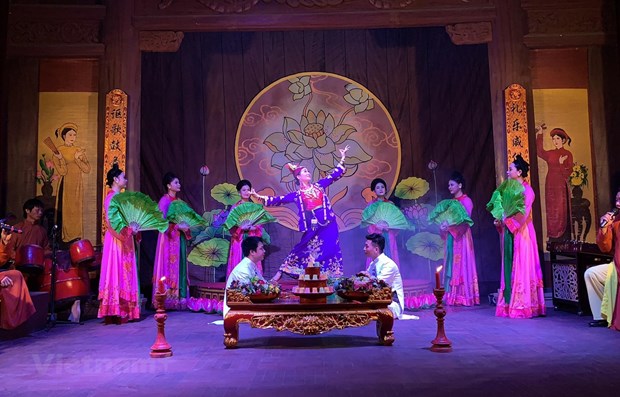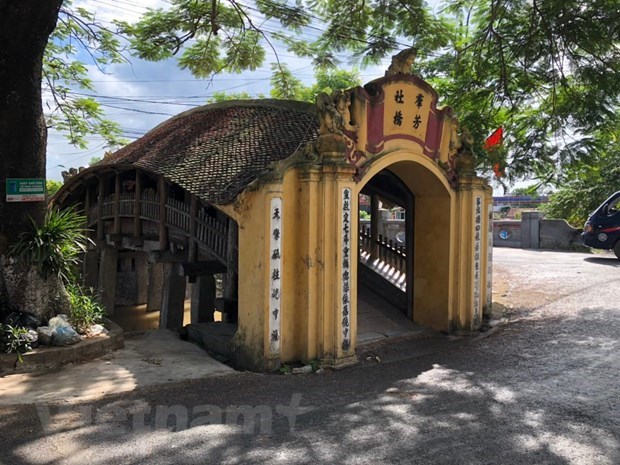Indigenous culture: future of Red River Delta’s green tourism
 A performance of Hau Dong rituals in Nam Dinh province (Photo: VietnamPlus)
A performance of Hau Dong rituals in Nam Dinh province (Photo: VietnamPlus)
Hanoi (VNA) – New-generation tourists are those who love, respect and show their responsibility for the environment. Therefore, there is a growing trend that vacationers explore special culture and intact ecosystem.
Although the Fourth Industrial Revolution is booming, indigenous culture remains attractive to tourists globally. In Vietnam, holiday-makers have no longer paid much attention to leisure tourism, but are turning to experiences during their trips.
Given this, the domestic tourism sector has devised a strategy in order to promote indigenous culture, firstly in the Red River Delta region, which has been dubbed as the cradle of the wet rice cultivation of Vietnam.
According to Ha Van Sieu, deputy head of the Vietnam National Administration of Tourism, localities will receive technical assistance to develop new tourist products bearing the characteristics of the indigenous culture and regional connectivity.
He stressed that regional connectivity will help diversify and raise the attractiveness of products.
 International visitors are interested in architecture in Red River Delta region (Photo: VietnamPlus)
International visitors are interested in architecture in Red River Delta region (Photo: VietnamPlus)Regarding the National Tourism Year 2020, to be hosted in Ninh Binh province, the official emphasised the programme’s message of high-tech applications aiming to create connectivity between the province and other localities nationwide.
“We expect that such events in Ninh Binh will help to develop tourist products in the Red River Delta region,” he said.
In the national action programme on tourismt, the Vietnam National Administration of Tourism last August sent a survey group to Ninh Binh and other localities like Thai Binh, Nam Dinh and Ha Nam.
Sieu added that Thai Binh province is home to historical relic sites and different genres of art like cheo (traditional opera).
 Cau (Bridge) Pagoda in Hai Anh commune, Hai Hau district, Nam Dinh province (Photo: VietnamPlus)
Cau (Bridge) Pagoda in Hai Anh commune, Hai Hau district, Nam Dinh province (Photo: VietnamPlus)The province has been encouraged to carry forward its strength in culture and landscapes, as well as the lifestyle and hospitality of locals, he said, suggesting that all localities should be hospitable to visitors.
Sieu said green and responsible tourism has been a trend and a target of the domestic tourism sector.
“We have set criteria regarding green and responsible tourism,” Sieu said.
In Vietnam, many businesses have joined national efforts to shift to green tourism by developing power-saving models and working to obtain the Vietnam National Administration of Tourism's Green Lotus label - a certification conferred on hotels and guesthouses that make efforts to protect the environment, use natural resources efficiently and preserve the country’s cultural heritage.
Last year, the country served some 15.6 million foreign tourists and 80 million domestic travellers, generating 620 trillion VND (26.66 billion USD) in tourism revenue.
The number of international tourist arrivals surged three-fold from 5 million in 2010 to over 15 million in 2018. The remarkable growth reflects the great efforts made by all players in the sector, particularly the large network of local travel agencies and strategic tourism investors nationwide.
The success has also been attributed to the large-scale and intensified efforts of tourism authorities to promote the country overseas. To aid such efforts, the Vietnam National Administration of Tourism has adopted a system of indicators to evaluate a destination and a tourism code of conduct; designed various plans to strengthen the management of travel agencies and tour guides; and raised awareness of the importance of quality among tourism service providers, local administrations, and tourism authorities.
According to the agency, to meet the demands of visitors from different markets, Vietnam has developed a diverse range of tourism products that make use of the country’s advantages, including cultural tours, sea-based tours, eco-tours, adventure tours, luxurious resort vacations, and more.
In 2019, Vietnam expects to welcome some 103 million visitors, including around 18 million foreign and 85 million domestic travellers, up 15 percent and 6 percent, respectively./.











